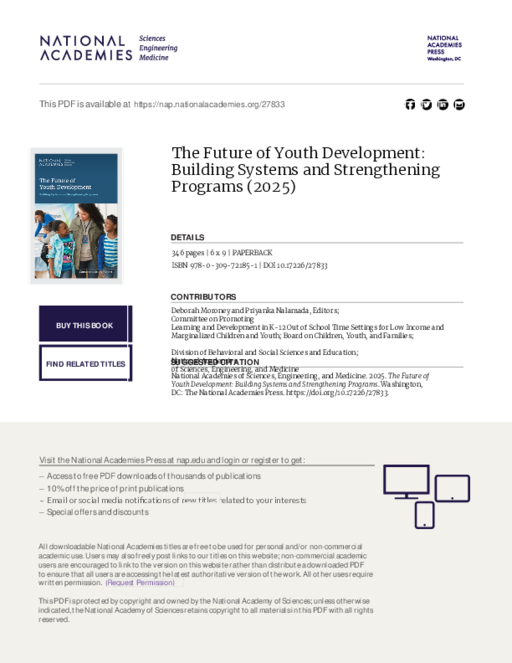Breadcrumb
- Wallace
- Reports
- The Future Of Youth Development ...
The Future of Youth Development
Building Systems and Strengthening Programs

- Author(s)
- Deborah Moroney and Priyanka Nalamada
- Publisher(s)
- The National Academies of Sciences, Engineering, and Medicine
- DOI Link
- https://doi.org/10.17226/27833
Summary
How we did this
The National Academies established a committee of experts with diverse backgrounds to conduct a consensus study on the learning and development of young people from low-income households in out-of-school time (OST) programs. The committee was asked to review the evidence in four key areas and consider the intersections between economic stress and other factors that have operated historically to marginalize young people.
Out-of-school time (OST) programs are a crucial component of child and youth development. They provide structured environments outside the traditional school day for young people to engage in meaningful activities, build relationships, and develop essential life skills.
In 2002, the National Academies of Sciences, Engineering, and Medicine released Community Programs for Youth Development (the “Blue Book”), a foundational report on the role and state of OST programming throughout the country. Since then, OST programs have grown and evolved significantly, as has the research and evidence base.
The Future of Youth Development: Building Systems and Strengthening Programs provides an updated look at OST programming in the U.S. This report examines the effectiveness of OST programs, identifies access and quality improvements, and outlines a future research agenda for the youth development field.
The review of the evidence base found that the field of youth development has experienced a number of changes over the past two decades. OST programs have become increasingly varied in their settings, programming, and the demographics of children and youth served. There has been greater consideration of cultural responsiveness that has shifted what program quality looks like. Also, while public and private OST funding has increased, so has the demand within communities.
The report offers extensive recommendations for federal, state, and local policymakers; intermediaries, such as state afterschool networks, municipal agencies, and nonprofit organizations, that coordinate efforts among program providers; and funders. The recommendations focus on six key goals to better support OST programs:
- Supporting stable OST funding
- Supporting local OST intermediaries
- Advancing program quality
- Supporting youth development practitioners
- Broadening understanding of OST programs
- Improving understanding of program outcomes
The report also outlines gaps in research around OST programs and needs for further research focused on access and engagement, program quality, staff development, and more.

This report serves to update the 2002 Blue Book: to recognize the growth, robustness, and complexity of the youth development field and consider ways in which OST programs can better serve the needs of all children and youth.
Key Takeaways
- OST programs have evolved significantly over the years, and they remain a crucial component of youth and adolescent development.
- OST programs have become more varied in settings and number of youth served; shifted in program quality through cultural responsiveness; and increased their budgets--though still not enough to keep up with demand for programs.
- High-quality OST programs and activities for young people require strong OST systems and organizational capacity; a stable, supported, and well-trained workforce; and programming responsive to the needs of the populations being served.
- Greater investment and policy coordination are necessary to expand access and improve program quality. Some recommendations for policymakers, agencies, and funders include supporting intermediaries, advancing program quality, and supporting the youth development workforce.

